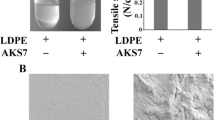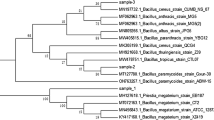Abstract
Polyethylene materials are a serious environmental concern as their nondegradable nature allows them to persist in the environment. Recent studies have shown that polyethylene can be degraded by microbes at a very slow rate, whereby detectable changes are evident after several years. In the present study, we report the degradation of low-density polyethylene by Pseudomonas sp. AKS2. Unlike the previous reports, degradation by Pseudomonas sp. AKS2 is relatively fast as it can degrade 5 ± 1 % of the starting material in 45 days without prior oxidation. This degradation can be altered by agents that modulate hydrophobic interaction between polythene and the microbe. As mineral oil promotes hydrophobic interactions, it enhances bacterial attachment to the polymer surface. This enhanced attachment results in increased biofilm formation and enhanced polymer degradation. In contrast, Tween 80 reduces bacterial attachment to the polymer surface by lowering hydrophobic interactions and thereby reduces polymer degradation. Thus, this study establishes a correlation between hydrophobic interaction and polymer degradation and also relates the biofilm formation ability of bacteria to polymer degrading potential.




Similar content being viewed by others
References
Albertsson AC (1978) Biodegradation of synthetic polymers: 2. Limited microbial conversion of C-14 in polyethylene to (CO-2)-C-14 by some soil fungi. J Appl Polym Sci 22:3419–3433
Albertsson AC (1980) The shape of the biodegradation curve for low and high density polyethylenes in prolonged series of experiments. Eur Polym J 16:623–630
Albertsson AC, Erlandsson B, Hakkarainen M, Karlsson S (1998) Molecular weight changes and polymeric matrix changes correlated with the formation of degradation products in biodegraded polyethylene. J Environ Polym Degrad 6:187–195
Balasubramanian V, Natarajan K, Hemambika B, Ramesh N, Sumathi CS, Kottaimuthu R, Rajash KV (2010) High-density polyethylene(HDPE)-degrading potential bacteria from marine ecosystem of Gulf of Mannar, India. Lett Appl Microbiol 51:205–211
Byuntae L, Anthony LP, Alfred F, Theodore BB (1991) Biodegradation of degradable plastic polyethylene by Phanerocheate and Streptomyces species. Appl Environ Microbiol 57:678–688
Chatterjee S, Roy B, Roy D, Banerjee R (2010) Enzyme-mediated biodegradation of heat treated commercial polyethylene by staphylococcal species. Polym Degrad Stab 95:195–200
Cornell JH, Kaplan AM, Rogers MR (1984) Biodegradation of photooxidized polyalkylenes. J Appl Polym Sci 29:2581–2597
Dubois M, Gilles KA, Hamilton JK, Rebers PA, Smith F (1956) Colorimetric method for determination of sugars and related substances. Anal Chem 28:350–356
Gilan I, Hadar Y, Sivan A (2004) Colonization, biofilm formation and biodegradation of polyethylene by a strain of Rhodococcus ruber. Appl Microbiol Biotechnol 65:97–104
Killham K, Staddon WJ (2002) Bioindicators and sensors of soil health and the application of geostatistics. In: Burns RG, Dick R (eds) Enzymes in the environment: activity, ecology and applications. Marcel Dekker, New York, pp 391–405
Lowry OH, Rosebrough NJ, Farr AL, Randall RJ (1951) Protein measurement with the Folin phenol reagent. J Biol Chem 193:265–275
Otake Y, Kobayashi T, Ashbe H, Murakami N, Ono K (1995) Biodegradation of low density polyethylene, polyvinyl-polyvinyl-chloride and urea-formaldehyde resin buried under soil for over 32 years. J Appl Polym Sci Symp 56:1789–1796
Potts JE (1978) Biodegradation. In: Jelinek HHG (ed) Aspects of degradation and stabilization of polymers. Elsevier, New York, pp 617–658
Roy PK, Titus S, Surekha P, Tulsi E, Deshmukh C, Rajagopal C (2008) Degradation of abiotically aged LDPE films containing pro-oxidant by bacterial consortium. Polym Degrad Stab 93:1917–1922
Soni R, Kapri A, Zaidi MGH, Goel R (2009) Comparative biodegradation studies of non-poronized and poronized LDPE using indigenous microbial consortium. J Environ Polym Degrad 17:233–239
Tansengco ML, Tokiwa Y (1998) Thermophilic microbial degradation of poly (ethylene succinate). World J Microbiol Biotechnol 14:133–138
Teng Y, Luo Y, Sun M, Liu Z, Li Z, Christie P (2010) Effect of bioaugmentation by Paracoccus sp. strain HPD-2 on the soil microbial community and removal of polycyclic aromatic hydrocarbons from an aged contaminated soil. Bioresour Technol 101:3437–3443
Tribedi P, Sarkar S, Mukherjee K, Sil AK (2012) Isolation of a novel Pseudomonas sp from soil that can efficiently degrade polyethylene succinate. Environ Sci Pollut Res 19:2115–2124
Volke-Sepulveda T, Saucedo-Castaneda G, Gutierrez-Rojas M, Manzur A, Favela-Torres E (2002) Thermally treated low density polyethylene biodegradation by Penicillium pinophilum and Aspergillus niger. J Appl Polym Sci 83:305–314
Yoon GM, Jeon JH, Kim NM (2012) Biodegradation of polyethylene by a soil bacterium and AlkB cloned recombinant cell. J Bioremed Biodegrad 3:145. doi:10.4172/2155-6199.1000145
Zahra S, Abbas SS, Mahsa MT, Mohsen N (2010) Biodegradation of low-density polyethylene (LDPE) by isolated fungi in solid waste medium. Waste Manag 30:396–401
Acknowledgments
The authors would like to thank Dr. Srimonti Sarkar for critical reading of the manuscript. PT is supported by CSIR-Senior Research Fellowship, Government of India. AFM facility was availed at central instrumental facility under DBT-IPLS program at University of Calcutta. This work is supported partly by a grant in aid for scientific research from the Department of Biotechnology, Government of West Bengal, India.
Conflict of interest
The authors declare no conflict of interest.
Author information
Authors and Affiliations
Corresponding author
Additional information
Responsible editor: Robert Duran
Rights and permissions
About this article
Cite this article
Tribedi, P., Sil, A.K. Low-density polyethylene degradation by Pseudomonas sp. AKS2 biofilm. Environ Sci Pollut Res 20, 4146–4153 (2013). https://doi.org/10.1007/s11356-012-1378-y
Received:
Accepted:
Published:
Issue Date:
DOI: https://doi.org/10.1007/s11356-012-1378-y




